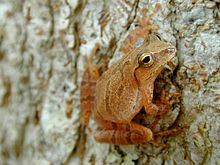
The ornate chorus frog is a species of chorus frog endemic to the Southeastern United States. Their distribution ranges from North Carolina, east to the very eastern part of Louisiana, and south to northern parts of Florida.
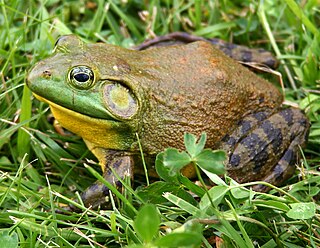
The American bullfrog, often simply known as the bullfrog in Canada and the United States, is a large true frog native to eastern North America. It typically inhabits large permanent water bodies such as swamps, ponds, and lakes. Bullfrogs can also be found in manmade habitats such as pools, koi ponds, canals, ditches and culverts. The bullfrog gets its name from the sound the male makes during the breeding season, which sounds similar to a bull bellowing. The bullfrog is large and is commonly eaten throughout its range, especially in the southern United States where they are plentiful.

The common frog or grass frog, also known as the European common frog, European common brown frog, European grass frog, European Holarctic true frog, European pond frog or European brown frog, is a semi-aquatic amphibian of the family Ranidae, found throughout much of Europe as far north as Scandinavia and as far east as the Urals, except for most of the Iberian Peninsula, southern Italy, and the southern Balkans. The farthest west it can be found is Ireland. It is also found in Asia, and eastward to Japan. The nominative, and most common, subspecies Rana temporaria temporaria is a largely terrestrial frog native to Europe. It is distributed throughout northern Europe and can be found in Ireland, the Isle of Lewis and as far east as Japan.

Lithobates sylvaticus or Rana sylvatica, commonly known as the wood frog, is a frog species that has a broad distribution over North America, extending from the boreal forest of the north to the southern Appalachians, with several notable disjunct populations including lowland eastern North Carolina. The wood frog has garnered attention from biologists because of its freeze tolerance, relatively great degree of terrestrialism, interesting habitat associations, and relatively long-range movements.

The American green tree frog is a common arboreal species of New World tree frog belonging to the family Hylidae. This nocturnal insectivore is moderately sized and has a bright green to reddish-brown coloration. Commonly found in the central and southeastern United States, the frog lives in open canopy forests with permanent water sources and abundant vegetation. When defending its territory, the frog either emits aggressive call signals or resolves to grapple with intruders, seldom leading to injury or death. To avoid predation, the frog will leap into the water or jump into the treetops.

The Pacific tree frog, also known as the Pacific chorus frog, has a range spanning the Pacific Northwest, from Northern California, Oregon, and Washington to British Columbia in Canada and extreme southern Alaska. They live from sea level to more than 10,000 feet in many types of habitats, reproducing in aquatic settings. They occur in shades of greens or browns and can change colors over periods of hours and weeks.
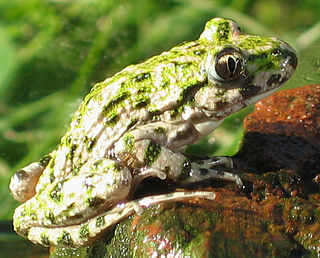
The common parsley frog is a species of frog in the genus Pelodytes. It lives in the Iberian region of southwestern Europe. Its earliest identification is believed to be from 1802.
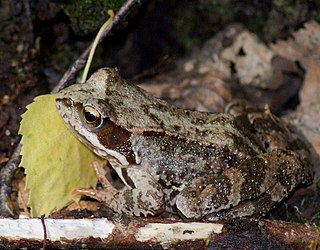
The moor frog is a slim, reddish-brown, semiaquatic amphibian native to Europe and Asia. Moor frogs are known for their ability to freeze solid and survive thawing. The frog makes use of various cryoprotectants i.e. antifreeze that decrease its internal freezing temperature. The species is distributed over a large range, covering a significant portion of Eurasia. Male moor frogs are known to turn blue temporarily during the height of mating season. This coloration is assumed to signal a mate's fitness. Moor frogs typically mate through multimale amplexus a form of polyandry.

The northern cricket frog is a species of small hylid frog native to the United States and northeastern Mexico. These frogs are majorly in grey, green, and brown color with blotching patterns. Many have a brown or orange stripe down the center of their back and a triangular marking on the top of their head. Despite being members of the tree frog family, they are not arboreal. These frogs prefer habitats near the edges of slow-moving bodies of water, and in close proximity to shelter items, like rocks. It has two recognized subspecies, A. c. crepitans and A. c. paludicola.

The gray treefrog is a species of small arboreal holarctic tree frog native to much of the eastern United States and southeastern Canada.

The Italian agile frog, also known as Lataste's frog, is a species of frog in the family Ranidae. The species is native to southern Europe, primarily found in the Po River Basin of Italy. It is one of the most endangered amphibian species in Europe, with its populations declining sharply in recent years, and has been the focus of multiple conservation plans.
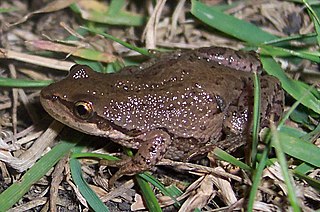
The boreal chorus frog is a species of chorus frog native to Canada from central Quebec to eastern British Columbia and north to the Northwest Territories and the southern portion of the Yukon. It occurs in the USA throughout Montana, northwestern Wisconsin, northeastern Arizona, northern New Mexico, and southwestern Utah.
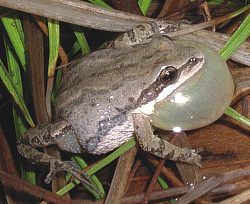
The western chorus frog, also known as striped chorus frog, or midland chorus frog is a species of frog found in Canada and the United States.
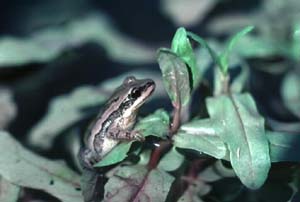
The upland chorus frog is a species of chorus frog found in the United States. It was recently separated from the Western chorus frog, being identified as an individual species rather than a subspecies. They are a rarely seen species, but their calls are frequently heard soon after rains in the spring time.

Dryophytes gratiosus, commonly known as the barking tree frog, is a species of tree frog endemic to the south-eastern United States. Formerly known as Hyla gratiosa.

The Panama cross-banded tree frog or pug-nosed tree frog is a species of frog in the family Hylidae found in the humid Pacific lowlands of southwestern Costa Rica to eastern Panama and in the Caribbean lowlands of Panama and northern Colombia. Males of the species utilize synchronous calling to hide their position from predators. Females create basins during amplexus and deposit fertilized eggs onto the surface of the water.
Hyperolius nitidulus is a species of frog from the family Hyperoliidae. It is found on the West African savannas between Guinea and Mali in the west and Nigeria and Cameroon in the east. Common name plain reed frog has been coined for it.

The Túngara frog is a species of frog in the family Leptodactylidae. It is a small nocturnal terrestrial frog found in Mexico, Central America, and the northeastern regions of South America.

The quacking frog, also known as the red-thighed froglet due to its legs tending to be bright red, is a species of frog from the Myobatrachidae family and is in a clad with five other species. The frog is well known for the sound it produces which resembles a quack. It has up to 11 notes and can change the notes in their call. It has larger testes compared to other frogs within the genus and has started to be used in experiments. This frog is found in southwest Australia. It is found in ponds and pools and other moisture filled areas. These frogs engage in polyandry and can result in multiple paternity of its offspring. Additionally, the tadpoles of this species can change the rate they metamorphosize depending on the conditions. The males tend to have larger arm girth and can adopt different mating strategies depending on size. The mating strategy is dependent on male density. The frogs also vary in terms of colour and texture of its skin. The tadpoles are generally golden with transparent tails.

Lithobates clamitans or Rana clamitans, commonly known as the green frog, is a species of frog native to eastern North America. The two subspecies are the bronze frog and the northern green frog.
